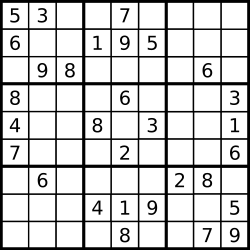Determine if a 9x9 Sudoku board is valid. Only the filled cells need to be validated according to the following rules:
- Each row must contain the digits
1-9without repetition. - Each column must contain the digits
1-9without repetition. - Each of the 9
3x3sub-boxes of the grid must contain the digits1-9without repetition.

The Sudoku board could be partially filled, where empty cells are filled with the character '.'.
Example 1:
Input:
[
["5","3",".",".","7",".",".",".","."],
["6",".",".","1","9","5",".",".","."],
[".","9","8",".",".",".",".","6","."],
["8",".",".",".","6",".",".",".","3"],
["4",".",".","8",".","3",".",".","1"],
["7",".",".",".","2",".",".",".","6"],
[".","6",".",".",".",".","2","8","."],
[".",".",".","4","1","9",".",".","5"],
[".",".",".",".","8",".",".","7","9"]
]
Output: true
Example 2:
Input:
[
["8","3",".",".","7",".",".",".","."],
["6",".",".","1","9","5",".",".","."],
[".","9","8",".",".",".",".","6","."],
["8",".",".",".","6",".",".",".","3"],
["4",".",".","8",".","3",".",".","1"],
["7",".",".",".","2",".",".",".","6"],
[".","6",".",".",".",".","2","8","."],
[".",".",".","4","1","9",".",".","5"],
[".",".",".",".","8",".",".","7","9"]
]
Output: false
Explanation: Same as Example 1, except with the 5 in the top left corner being
modified to 8. Since there are two 8's in the top left 3x3 sub-box, it is invalid.
Note:
- A Sudoku board (partially filled) could be valid but is not necessarily solvable.
- Only the filled cells need to be validated according to the mentioned rules.
- The given board contain only digits
1-9and the character'.'. - The given board size is always
9x9.
题目:判断给定的二维数组是否为有效的数独。该数独不一定有解,只需判断是否满足数独的规则:每行不能有重复的数字,每列不能有重复的数字,每个九宫格不能有重复的数字。
思路: 创建三个unordered_map<int, unordered_set<char>>,将数据重新规整化存入其中,判断是否有重复的元素。其中行,列的序号可由i和j控制,九宫格的序号可通过(i/3)*3+j/3计算得到。可参考具体分析。
#include<iostream>
#include<vector>
#include<unordered_set>
#include<unordered_map>
#include<algorithm>
using namespace std;
class Solution {
public:
bool isValidSudoku(vector<vector<char>>& board) {
int r = board.size();
int c = board[0].size();
//将数据重新存放在不同的map中,三个map的key分别表示行序号,列序号,九宫格序号。
unordered_map<int, unordered_set<char> > rows;
unordered_map<int, unordered_set<char> > cols;
unordered_map<int, unordered_set<char> > grids;
for(int i=0; i< r; i++){
for(int j=0; j< c; j++){
if(board[i][j] == '.')
continue;
auto iter = rows[i].find(board[i][j]);
if(iter != rows[i].end())
return false;
else
rows[i].insert(board[i][j]);
iter = cols[j].find(board[i][j]);
if(iter != cols[j].end())
return false;
else
cols[j].insert(board[i][j]);
iter = grids[(i/3)*3+j/3].find(board[i][j]);
if(iter != grids[(i/3)*3+j/3].end())
return false;
else
grids[(i/3)*3+j/3].insert(board[i][j]);
}
}
return true;
}
};
int main(int argc, char const *argv[])
{
Solution sln;
vector<vector<char>> testcase{
{'5','3','.','.','7','.','.','.','.'},
{'6','.','.','1','9','5','.','.','.'},
{'.','9','8','.','.','.','.','6','.'},
{'8','.','.','.','6','.','.','.','3'},
{'4','.','.','8','.','3','.','.','1'},
{'7','.','.','.','2','.','.','.','6'},
{'.','6','.','.','.','.','2','8','.'},
{'.','.','.','4','1','9','.','.','5'},
{'.','.','.','.','8','.','.','7','9'}
};
cout << sln.isValidSudoku(testcase) << endl;
return 0;
}